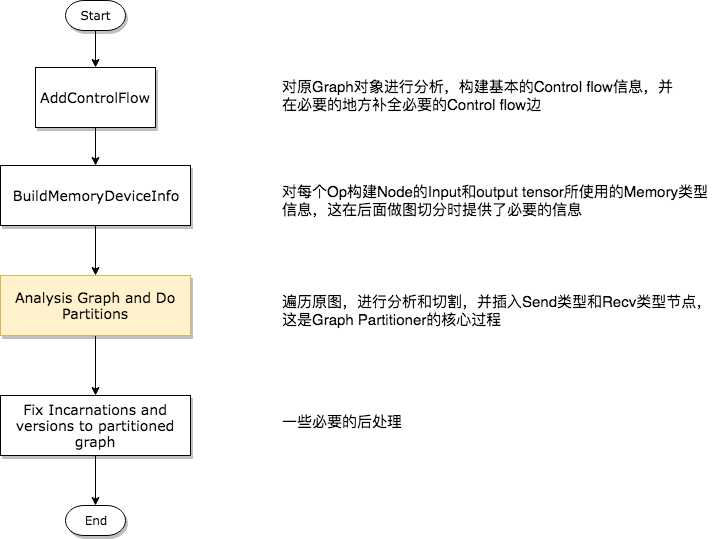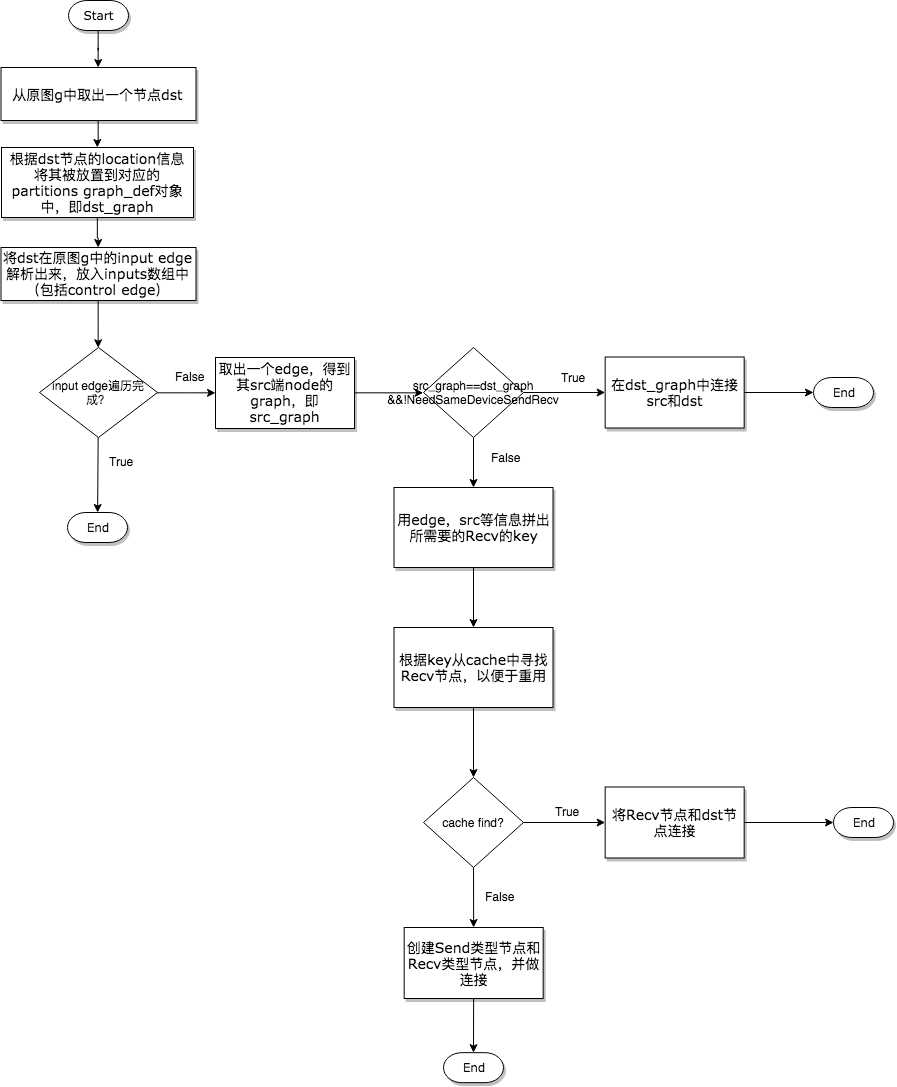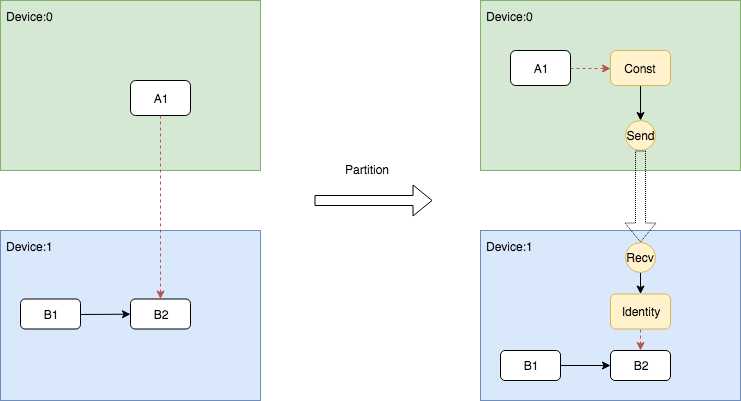标签:ati blank session target 理解 matching sig 完全 distrib

1 GraphInfo g_info; 2 if (!opts.control_flow_added) { 3 // Add the "code" for distributed execution of control flow. Code is 4 // added only for the frames that are placed on multiple devices. The 5 // new graph is an equivalent transformation of the original graph and 6 // has the property that it can be subsequently partitioned arbitrarily 7 // (down to the level of individual device) for distributed execution. 8 status = AddControlFlow(opts, g, &g_info); 9 if (!status.ok()) return status; 10 }
1 // MemoryType is used to describe whether input or output Tensors of 2 // an OpKernel should reside in "Host memory" (e.g., CPU memory) or 3 // "Device" Memory (CPU memory for CPU devices, GPU memory for GPU 4 // devices). 5 enum MemoryType { 6 DEVICE_MEMORY = 0, 7 HOST_MEMORY = 1, 8 };
1 #define REGISTER_GPU_KERNEL(type) 2 REGISTER_KERNEL_BUILDER(Name("Reshape") 3 .Device(DEVICE_GPU) 4 .HostMemory("shape") 5 .TypeConstraint<type>("T") 6 .TypeConstraint<int32>("Tshape"), 7 ReshapeOp); 8 REGISTER_KERNEL_BUILDER(Name("Reshape") 9 .Device(DEVICE_GPU) 10 .HostMemory("shape") 11 .TypeConstraint<type>("T") 12 .TypeConstraint<int64>("Tshape"), 13 ReshapeOp);
上面的宏显示,虽然Reshape Op确实在GPU上有注册的实现版本,但是它依然要使用HostMemory。另外,某些Tensor的类型也决定了其是否可以被放置到Device Memory上,一般情况下float类型的数据对于计算设备是非常友好的,而String类型就不是这样,所以在types.cc文件中规定了一些强制被放在HostMemory的数据类型,如下代码所示。
1 bool DataTypeAlwaysOnHost(DataType dt) { 2 // Includes DT_STRING and DT_RESOURCE. 3 switch (dt) { 4 case DT_STRING: 5 case DT_STRING_REF: 6 case DT_RESOURCE: 7 return true; 8 default: 9 return false; 10 } 11 }

1 // Check whether there is already a send/recv pair transferring 2 // the same tensor/control from the src to dst partition. 3 const bool on_host = IsDstInputOnHost(edge, g_info); 4 DupRecvKey key{src->id(), edge->src_output(), dst_graph, on_host}; 5 auto iter = dup_recv.find(key); 6 if (iter != dup_recv.end()) { 7 // We found one. Reuse the data/control transferred already. 8 const string& recv_node_name = iter->second.recv->name(); 9 if (edge->IsControlEdge()) { 10 AddInput(dst_def, recv_node_name, Graph::kControlSlot); 11 } else { 12 AddInput(dst_def, recv_node_name, 0); 13 } 14 ref_control_inputs.push_back(recv_node_name); 15 16 // We want the start_time for the recv to be the smallest of the start 17 // times of it‘s consumers. So we update this whenever we use a recv, 18 // and write it out to the attribute at the end of the subroutine 19 if (iter->second.start_time > recv_start_time) { 20 iter->second.start_time = recv_start_time; 21 } 22 continue; 23 }
1 const FunctionLibraryDefinition* flib_def = opts.flib_def; 2 if (flib_def == nullptr) { 3 flib_def = &g->flib_def(); 4 } 5 6 // Set versions, function library and send/recv incarnation. 7 for (auto& it : *partitions) { 8 GraphDef* gdef = &it.second; 9 *gdef->mutable_versions() = g->versions(); 10 // Prune unreachable functions from `flib_def` before adding them to `gdef`. 11 *gdef->mutable_library() = flib_def->ReachableDefinitions(*gdef).ToProto(); 12 13 // Traverse the graph to fill every send/recv op‘s incarnation 14 // information. 15 SetIncarnation(opts, gdef); 16 }
在代码中,声明插入Send和Recv节点的代码段非常简单,如下所示。
1 // Need to split edge by placing matching send/recv nodes on 2 // the src/dst sides of the edge. 3 NodeDef* send = AddSend(opts, g_info, src_graph, edge, send_from, 4 send_start_time, &status); 5 if (!status.ok()) return status; 6 7 NodeDef* real_recv = nullptr; 8 NodeDef* recv = 9 AddRecv(opts, g_info, dst_graph, edge, &real_recv, &status); 10 if (!status.ok()) return status;
但是对于不同的情况却有着丰富的处理逻辑,所以下面在展示示意图的同时,会将相关的代码段摘出来做展示。
因为同一个Device上的Send和Recv节点在执行过程中实际上Memory Copy,而Recv的kernel又是异步的,所以需要有一种机制保证保证Recv一定要在Send之后执行,因此需要在Send和Recv之间插入一个Control Edge,从图的依赖上保证它们的执行顺序。

这个过程的关键是在插入Send和Recv节点之后,需要插入额外的Control Edge,代码如下。
// Fix up the control flow edge. // NOTE(yuanbyu): ‘real_recv‘ must be the real recv node. if (src_graph == dst_graph) { // For same device send/recv, add a control edge from send to recv. // This prevents the asynchronous recv kernel from being scheduled // before the data is available. AddInput(real_recv, send->name(), Graph::kControlSlot); }


1 NodeDefBuilder::NodeOut send_from; 2 if (edge->IsControlEdge()) { 3 // Insert a dummy const node that will generate a tiny 4 // data element to be sent from send to recv. 5 VLOG(1) << "Send/Recv control: " << src->assigned_device_name() << "[" 6 << src->name() << "] -> " << dst->assigned_device_name() << "[" 7 << dst->name() << "]"; 8 NodeDef* dummy = AddDummyConst(opts, src_graph, edge, &status); 9 if (!status.ok()) return status; 10 // Set the start time for this dummy node. 11 if (opts.scheduling_for_recvs) { 12 AddNodeAttr("_start_time", send_start_time, dummy); 13 } 14 AddInput(dummy, src->name(), Graph::kControlSlot); 15 send_from.Reset(dummy->name(), 0, DT_FLOAT); 16 } else { 17 send_from.Reset(src->name(), edge->src_output(), EdgeType(edge)); 18 }
Indentity即相关依赖的插入逻辑被写在了AddRecv中,下面展示了这个片段。
1 // Add the cast node (from cast_dtype to dtype) or an Identity node. 2 if (dtype != cast_dtype) { 3 const string cast_op = (host_memory) ? "_HostCast" : "Cast"; 4 NodeDefBuilder cast_builder(opts.new_name(src->name()), cast_op); 5 cast_builder.Attr("DstT", dtype); 6 cast_builder.Device(dst->assigned_device_name()) 7 .Input(recv->name(), 0, cast_dtype); 8 NodeDef* cast = gdef->add_node(); 9 *status = cast_builder.Finalize(cast); 10 if (!status->ok()) return nullptr; 11 return cast; 12 } else if (edge->IsControlEdge()) { 13 // An Identity is only needed for control edges. 14 NodeDefBuilder id_builder(opts.new_name(src->name()), "Identity"); 15 id_builder.Device(dst->assigned_device_name()) 16 .Input(recv->name(), 0, cast_dtype); 17 NodeDef* id = gdef->add_node(); 18 *status = id_builder.Finalize(id); 19 if (!status->ok()) return nullptr; 20 return id; 21 } else { 22 return recv; 23 }
TensorFlow支持通过使用bfloat16减少通信量,虽然bfloat16理论上是有损精度的,但是大量的实践证明这个精度损失是基本感知不到的。bfloat16的通信功能可以通过以下配置项打开,只要在创建Session时传入打开该功能的config即可。
graph_options = tf.GraphOptions(enable_bfloat16_sendrecv=True) session_config = tf.ConfigProto(gpu_options=gpu_options)
TensorFlow的图切割模块——Graph Partitioner
标签:ati blank session target 理解 matching sig 完全 distrib
原文地址:https://www.cnblogs.com/deep-learning-stacks/p/10054529.html